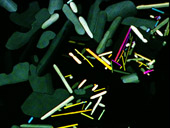Research
More Information

Current Projects
Control of Calcium Oxalate Crystallization
Because it is the main component of kidney stones, methods to control the crystallization of calcium oxalate are medically important. It is known that some proteins are able to control the kinetics of CaOx growth by adsorbing to crystal faces. We are investigating this process by in-situ atomic-force microscopy.
Mechanical Properties of Nanomaterials
The ability of the AFM to measure forces at the pico-Newton scale with nanometer lateral resolution is well-suited to the study of nanomaterials such as carbon nanotubes. More info ...
Atomic Force Microscopy Techniques
One of the primary experimental instruments employed in my research is the atomic force microscope (AFM), which can measure structures and forces at the nanometer and pico-Newton levels. Barely 20 years old, development of new AFM techniques continues. More info ...
Recent Projects
Poly(vinyl alcohol) Hydrodgels
Hydrogels are a soft material typically comprised of a sparse network of cross-linked polymers embedded in a fluid matrix—one well-known example is Jello. We are utilizing a variety of techniques, including small-angle neutron scattering, light scattering, macroscopic mechanical testing, and numerical modeling to investigate the properties of anisotropic PVA hydrogels, which are promising for medical applications such as vascular grafts and wound-dressing materials. More info ...
Alkane Crystallization
Crystallization is a fundamental physical process that is important in many fields: materials science, geology, the petroleum industry, and even medicine. One of our past projects involved the crystallization of normal alkanes—paraffin wax. Although this might seem mundane at first glance, there are several reasons to study this system. More info ...
Adhesive and Mechanical Properties of Cells
Through a collaboration with research groups in Biomedical Engineering and the Robarts Research Institute, we have performed atomic-force microscopy studies of biological cells in order to better understand their structure, mechanical properties and adhesive properties. More info ...


